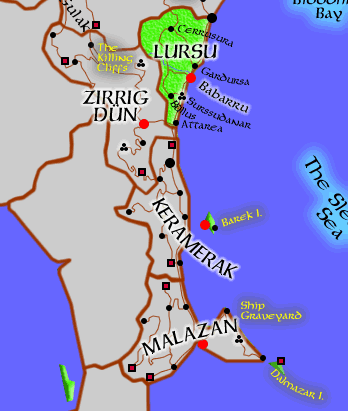Overview
The boggy kingdom of Lursū has long been considered the poorest and most filthy kingdom in the region. The heraldic device of the capital City of Babàrrū depicts two rampant swine with a knotty Dorg fruit locked between their tusked jaws. Natives of Lursū claim the swine are proudly holding the fruit aloft, while others claim that even the swine are so poor that they must fight for food.
Government
- Type – Lursūri Monarchy
- Ruler – King Grâl Kadùrgū II
- Capital – City of Babàrrū
- Cities – …
- Calendar – …
- Festivals – …
People
- Population – Lursūryr (650 DR) 113,100
- Races – Yrūn 82%, Shul 14%, Urdar 2%, other 2%
- Ethnicities –
- Languages – Lursūric, Saráddic
- Religions –
Trade
- Currency –
- Imports – Ale, cheese, produce, textiles
- Exports – Swine, wine
Dorg fruit is a “delicacy” among the Lursūryr, despite the foul stench given off by its rotting husks. The hard-husked fruits drop to the ground where they lay until they are eaten by swine, collected by gatherers, or eventually sink into the bog (to seed a new tree). Not only do the rotten husks smell bad, but they permanently stain fingers and hands with unmistakable greenish-black markings. The interior of the fruit is a sweet tasting meaty delight for those who not subjected to the smell of the husks.
Lursū is a haven of last resort for outlaws and refugees. Most nearby governments will not pursue criminals into Lursū and do not bother maintaining embassies or relations with the kingdom’s Crown. Swine, salted meats, and Dorg wine are the kingdom’s sole exports.
Regions, Geographic
Regions, Political
Cities, Towns, and Villages
- City of Babàrrū
Landmarks
- Surssùdanar
People
History
Time Line
Dynasties
Nomenclature: Lursū Dekàlic: Lursū (place), Lursūri (pertaining to), Lursūryn (resident), Lursūryr (people), Lursūric (language)
